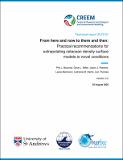Files in this item
From here and now to there and then : practical recommendations for extrapolating cetacean density surface models to novel conditions
Item metadata
| dc.contributor.author | Bouchet, Philippe Jean-Francois | |
| dc.contributor.author | Miller, David Lawrence | |
| dc.contributor.author | Roberts, Jason | |
| dc.contributor.author | Mannocci, Laura | |
| dc.contributor.author | Harris, Catriona M | |
| dc.contributor.author | Thomas, Len | |
| dc.date.accessioned | 2019-09-19T10:30:02Z | |
| dc.date.available | 2019-09-19T10:30:02Z | |
| dc.date.issued | 2019-09-04 | |
| dc.identifier | 261009868 | |
| dc.identifier | d93b3865-dfc9-4b1c-bdf1-193183897df0 | |
| dc.identifier.citation | Bouchet , P J-F , Miller , D L , Roberts , J , Mannocci , L , Harris , C M & Thomas , L 2019 , From here and now to there and then : practical recommendations for extrapolating cetacean density surface models to novel conditions . CREEM Technical Report , no. 2019-1 , University of St Andrews . | en |
| dc.identifier.other | ORCID: /0000-0002-7436-067X/work/61369990 | |
| dc.identifier.other | ORCID: /0000-0001-9198-2414/work/61370031 | |
| dc.identifier.other | ORCID: /0000-0002-2144-2049/work/61979019 | |
| dc.identifier.uri | https://hdl.handle.net/10023/18509 | |
| dc.description.abstract | Density surface models (DSMs) are clearly established as a method of choice for the analysis of cetacean line transect survey data, and are increasingly used to inform risk assessments in remote marine areas subject to rising anthropogenic impacts (e.g. the high seas). However, despite persistent skepticism about the validity of extrapolated models, more and more DSMs are being applied well beyond the boundaries of the study regions where field sampling originally took place. This leads to potentially uncertain and error-prone model predictions that may mislead on-the-ground management interventions and undermine conservation decision-making. In addition, no consensus currently exists on the best way to define and measure extrapolation when it occurs, leaving users without the tools they require to audit models projected into novel conditions. Consequently, a transparent and consistent protocol for identifying scenarios under which extrapolation may be appropriate (or conversely, ill-advised) is urgently needed to better gauge how models behave outside the boundaries of sample data and to know how much faith can be placed in their outputs. This report aims to address this gap by synthesising recent advances in extrapolation detection, and presenting recommendations for a minimum standard for measuring extrapolation in novel environmental space. Such guidelines are essential to promoting transparency, replicability, and quality control, and will help marine scientists, managers and policy agencies to (i) better interpret density surfaces and their associated uncertainty; (ii) refine model development and selection approaches; and (iii) optimise the allocation of future survey effort by identifying priority knowledge gaps, e.g. by delineating areas where model predictions are the least supported by data. Our review is accompanied by supplementary R code offering a user-friendly framework for quantifying, summarising and visualising various forms of extrapolation in multivariate environmental space a priori (ahead of model fitting). We illustrate its application with case studies designed to revisit previously published predictions of sperm whale (Physeter macrocephalus) and beaked whale (Ziphiidae spp.) densities in the Northwest Atlantic, and evaluate them in light of several extrapolation metrics. Very early in their training, ecologists are given strong warnings against extrapolating, as model predictions made in data-deficient contexts rely heavily on assumptions that may not hold outside the range of sampled conditions. Navigating the ‘uncharted waters’ of extrapolation, however, is critical to scientific progress, and will be best achieved with a clear understanding of the mechanics, benefits, and limitations of extrapolated models. | |
| dc.format.extent | 59 | |
| dc.format.extent | 10602258 | |
| dc.language.iso | eng | |
| dc.publisher | University of St Andrews | |
| dc.relation.ispartofseries | CREEM Technical Report | en |
| dc.subject | GC Oceanography | en |
| dc.subject | QH301 Biology | en |
| dc.subject | SDG 14 - Life Below Water | en |
| dc.subject.lcc | GC | en |
| dc.subject.lcc | QH301 | en |
| dc.title | From here and now to there and then : practical recommendations for extrapolating cetacean density surface models to novel conditions | en |
| dc.type | Report | en |
| dc.contributor.institution | University of St Andrews. School of Mathematics and Statistics | en |
| dc.contributor.institution | University of St Andrews. Centre for Research into Ecological & Environmental Modelling | en |
| dc.contributor.institution | University of St Andrews. Applied Mathematics | en |
| dc.contributor.institution | University of St Andrews. Scottish Oceans Institute | en |
| dc.contributor.institution | University of St Andrews. School of Biology | en |
| dc.contributor.institution | University of St Andrews. Sea Mammal Research Unit | en |
| dc.contributor.institution | University of St Andrews. Statistics | en |
| dc.contributor.institution | University of St Andrews. Marine Alliance for Science & Technology Scotland | en |
This item appears in the following Collection(s)
Items in the St Andrews Research Repository are protected by copyright, with all rights reserved, unless otherwise indicated.

